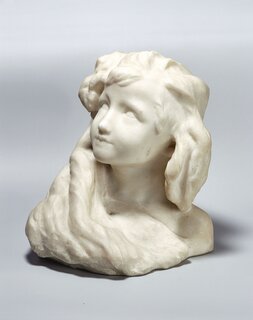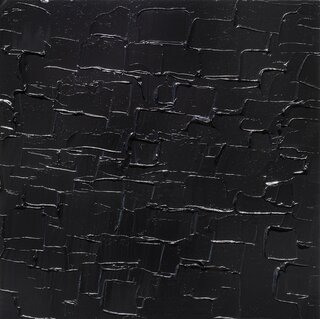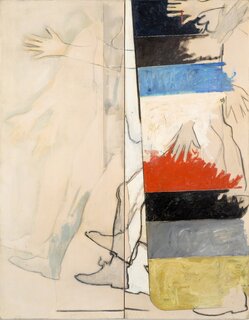
"Art is frivolous even when it takes itself seriously.
—François Morellet
Over the course of more than six decades, François Morellet developed a singular approach to geometric abstraction, pursuing rigorous objectivity with a sense of irreverence and unpretentious humor. Drawing on such diverse sources as the arabesque patterns at the Alhambra Palace in Granada, Max Bill’s concrete art, and John Cage’s musical compositions, he developed a method he termed “programmed experimental painting.” Rejecting the subjectivity of Art Informel, he relied on a vocabulary of straight lines and simple shapes—circles, triangles, and squares. As a way to achieve what he described as “impersonality” or
“neutrality” in his work, he introduced systems and algorithms that would generate patterns. Around this time, he also decided to break with tradition and use square, rather than rectangular, canvases. Determined by “a single arbitrary decision”—the choice of the length of one side—the square format allowed Morellet to reduce the decision-making involved in producing a work. The square canvas also pays homage to some of the 20th century’s most vanguard artists, including Kazimir Malevich and Josef Albers, both of whom Morellet named as influences.
One of a series titled with some variation of Répartition aléatoire de carrés, the present work makes use of a predetermined system of chance operations that allowed him to neutrally and objectively create a composition. To produce Répartition aléatoire de 40 000 carrés suivant les chiffres pairs et impairs d’un annuaire de téléphone, 50% rouge, 50% blanc (Random Distribution of 40,000 Squares Following the Odd and Even Numbers of a Phone Book, 50% Red, 50% White, 1961), Morellet first divided the space of the picture plane into 40,000 squares measuring 1/16th of a centimeter on each side. To determine the arrangement of squares, Morellet’s wife or sons would read aloud from a local phone book. Upon hearing their recitation of the last four digits of each phone number, Morellet would mark a square red for an even number and leave the square blank for an odd number, making it white. Applied to a wood panel using a silkscreen technique, the resulting image has a visual effect akin to white noise; no focal point is discernable among the aggregations of red and white squares, and the anonymous nature of the silkscreen method removes any idiosyncrasies indicating the artist’s hand. The concept for the series came about during a conversation Morellet had with Ellsworth Kelly in 1958, when Kelly was living in France. After visiting the studio of Jean Arp, Kelly told Morellet about Arp and Sophie Taeuber’s 1917 paper collages, for which the artists scattered scraps of paper across supports in order to relinquish control of their expressive capacities.
In 1963, Morellet would realize the largest iteration of this Répartition aléatoire de carrés series for the 3rd Paris Biennale, when he installed a room-sized version of the work. Pairing two hues of equal saturation and contrasting colors (blue and red), Morellet created a vertiginous space of ocular sensation. The works in the series make visible the binary systems of digital technology, presenting the spectator with an object of pure information. In this way, Répartition aléatoire de 40 000 carrés presents a remarkably modern image (the static of video noise and the pixilation of digital images come to mind) born from a system of directives through which “readymade” data was filtered. The work achieves complexity through its embrace of simplicity and repetition.
This work has been registered by the Estate of François Morellet under no. 61041."




